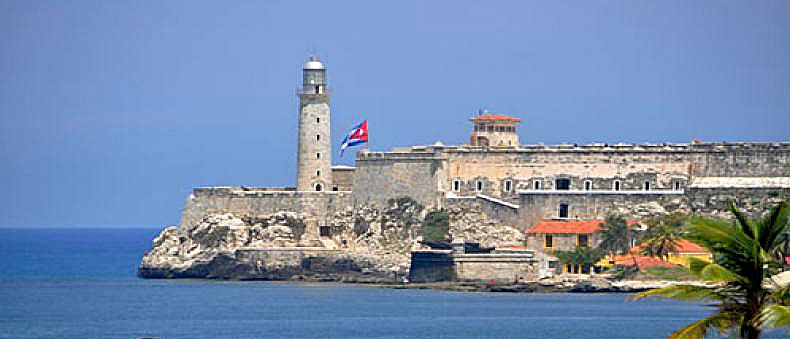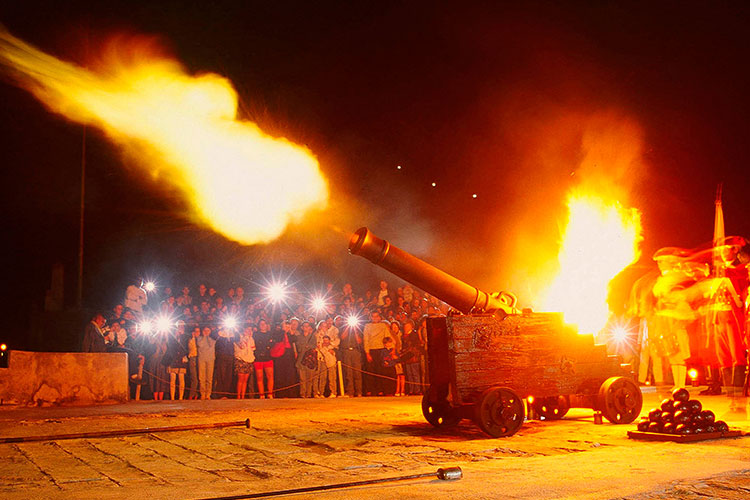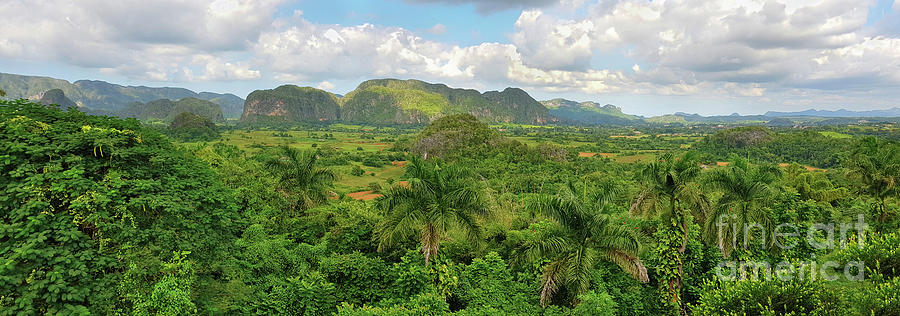En cualquier confín del mundo que se encuentre un habanero, jamás podrá olvidar una antiquísima costumbre de la tierra que lo vio nacer.
Con puntualidad más allá de la exactitud, todos los días del año, ya sean de fiesta o de duelo, a las nueve de la noche, ni un minuto más ni un minuto menos, desde la Fortaleza de San Carlos de la Cabaña se dispara un cañonazo, llamando a revisar los relojes.
Convertida en nuestros días en un vistoso espectáculo, en sus orígenes era la fórmula oficial de aviso a pobladores y visitantes de la capital cubana, para que a partir de ese instante permanecieran tras las gruesas murallas que a lo largo de decenas de kilómetros rodeaban la villa para resguardarla contra ataques de corsarios y piratas.
El tradicional cañonazo de las nueve, se inició en el siglo XVIII cuando desde la Fortaleza San Carlos de la Cabaña disparaban una salva para anunciar a los vecinos el momento de cerrar las puertas de la muralla que a lo largo de decenas de kilómetros rodeaban la villa de San Cristóbal para resguardarla contra ataques de corsarios y piratas.
La muralla, impresionante cinturón de piedra, fue construida por orden de la corona española para defenderse de tan peligrosos visitantes. De aquella obra quedan algunos tramos en lo que hoy es La Habana Vieja.
En 1863 comenzó el derribo de las murallas de La Habana, pero la tradición del cañonazo de las nueve perdura hasta el presente como un llamado a conservar nuestras tradiciones.
Un suceso curioso ocurrió el 18 de septiembre de 1902, el tradicional disparo se efectuó 30 minutos después de lo establecido. La algarabía que se armó fue muy grande, pero aún se ignora la causa de tan insólita tardanza.
La ceremonia se ha dejado de efectuar en 1942 durante la II Guerra Mundial y en 1945 se reinició la tan antigua costumbre.
El disparo además de realizarse en la fortaleza San Carlos de la Cabaña, se ha realizado desde el barco Infanta Isabel, anclado en la entrada de la bahía durante el siglo XIX.
Se asegura que el cañonazo se puede escuchar en buena parte de la ciudad. En el Parque Central a los 4,3 segundos; en el Hotel Nacional a los 9,7 y en la esquina de 23 y 12 a los 16 segundos del estampido original.
Convertida en nuestros días en un vistoso espectáculo desde la fortaleza de San Carlos de la Cabaña la ceremonia del “cañonazo” recrea un desfile militar con atributos y técnica de la etapa colonial, y concluye con el disparo de una salva desde uno de los cañones ubicados en la Cabaña, justo a las 9 de la noche.
Como testifica la historia, el disparo del cañón a las 21:00 horas indicaba que las puertas de la muralla se cerraban. Nadie entraba, nadie salía. Era la hora del silencio.
Pero en estos días justo a la misma hora en que suena en La Habana el patrimonial cañonazo, se rompe la calma y el silencio de las noches con el Aplauso Gigante de todos los cubanos desde cada balcón o ventana de la isla, en un homenaje masivo a los verdaderos héroes de estos tiempos.
A los médicos, enfermeros, técnicos y a todo el personal de la salud que desafían el riesgo viéndole el rostro más de cerca a la pandemia y que desde cualquier lugar combaten la COVID-19, palmadas de toda Cuba para quienes salvan al mundo.
 * RECOMIENDENOS A SUS AMISTADES * PREFIERA A NUESTROS SPONSORS. *
* RECOMIENDENOS A SUS AMISTADES * PREFIERA A NUESTROS SPONSORS. *
 THE CENTENARY CAÑONAZO of NINE O’CLOCK IN OUR OLD HAVANA. PHOTOS.
THE CENTENARY CAÑONAZO of NINE O’CLOCK IN OUR OLD HAVANA. PHOTOS.
In any corner of the world that an habanero is, he can never forget an ancient custom of the land that saw him born.
With punctuality beyond accuracy, every day of the year, whether it is a party or a duel, at nine o’clock at night, not a minute more or a minute less, from the Fortress of San Carlos de la Cabaña a fire is fired. cannon shot, calling to check the clocks.
Nowadays, it became a showy spectacle, originally it was the official formula for warning residents and visitors of the Cuban capital so that from that moment they remained behind the thick walls that for tens of kilometers surrounded the town. to protect it against attacks by corsairs and pirates.
The traditional nine o’clock cannon shot began in the 18th century when they fired a salvo from the San Carlos de la Cabaña Fortress to announce to the neighbors the moment to close the gates of the wall that for tens of kilometers surrounded the town of San Cristóbal to protect it against attacks by corsairs and pirates.
The impressive stone belt wall was built by the order of the Spanish crown to defend against such dangerous visitors. Some sections of that work remain in what is now Old Havana.
In 1863 the demolition of the walls of Havana began, but the tradition of the nine o’clock cannon lasts until today as a call to preserve our traditions.
A curious event occurred on September 18, 1902, the traditional shot was made 30 minutes after the established. The hubbub that arose was very great, but the cause of such an unusual delay is still unknown.
The ceremony was discontinued in 1942 during World War II and in 1945 the ancient custom was reinitiated.
The shooting, in addition to being carried out in the San Carlos de la Cabaña fortress, was fired from the Infanta Isabel ship, anchored at the entrance to the bay during the 19th century.
It is ensured that the cannon can be heard in much of the city. In Central Park at 4.3 seconds; at the Hotel Nacional at 9.7 and at the corner of 23 and 12 at 16 seconds of the original boom.
Nowadays turned into a showy spectacle from the fortress of San Carlos de la Cabaña, the “cannon shot” ceremony recreates a military parade with attributes and techniques of the colonial period, and concludes with the firing of a salvo from one of the cannons located at the Cabaña, just at 9 at night.
As history testifies, the firing of the cannon at 9:00 p.m. indicated that the gates of the wall were closing. No one entered, no one left. It was the hour of silence.
But these days just at the same time that the patrimonial cannon shot sounds in Havana, the calm and silence of the nights are broken with the Giant Applause of all Cubans from every balcony or window on the island, in a massive tribute to the true heroes of these times.
To the doctors, nurses, technicians, and all health personnel who defy risk by looking more closely at the pandemic and who fight COVID-19 from anywhere, claps from all over Cuba for those who save the world.
Agencies/ Wiki/ RHC/ Maria Calvo/ Internet Photos/ Arnoldo Varona/ www.TheCubanHistory.com
THE CUBAN HISTORY, HOLLYWOOD.









